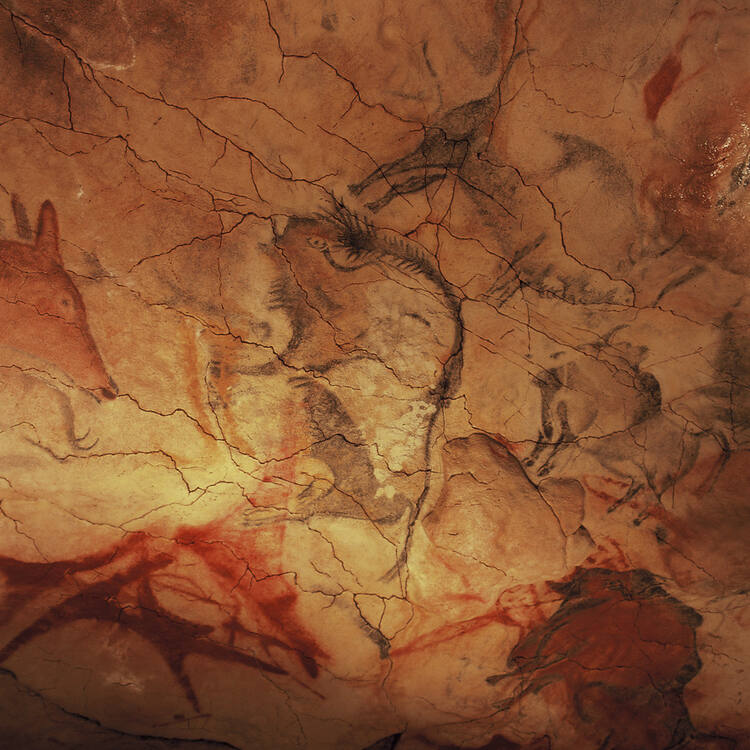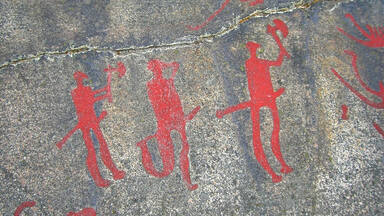Cave of Altamira and Paleolithic Cave Art of Northern Spain
Cave of Altamira and Paleolithic Cave Art of Northern Spain
Seventeen decorated caves of the Paleolithic age were inscribed as an extension to the Altamira Cave, inscribed in 1985. The property will now appear on the List as Cave of Altamira and Paleolithic Cave Art of Northern Spain. The property represents the apogee of Paleolithic cave art that developed across Europe, from the Urals to the Iberian Peninusula, from 35,000 to 11,000 BC. Because of their deep galleries, isolated from external climatic influences, these caves are particularly well preserved. The caves are inscribed as masterpieces of creative genius and as the humanity’s earliest accomplished art. They are also inscribed as exceptional testimonies to a cultural tradition and as outstanding illustrations of a significant stage in human history.
Description is available under license CC-BY-SA IGO 3.0
Grotte d’Altamira et art rupestre paléolithique du nord de l’Espagne
Dix-sept grottes ornées datant du Paléolithique ont été ajoutées en tant qu’ extension du site de la grotte d’Altamira, inscrit en 1985. Ce bien apparaîtra désormais sur la Liste sous le nom de La grotte Altamira et l’art rupestre paléolithique du Nord de l’Espagne. L’ensemble illustre l’apogée de l’art rupestre paléolithique qui s’est développé à travers l’Europe, de l’Oural à la péninsule Ibérique, de 35 000 à 11 000 ans avant J.-C. On doit son excellente conservation au fait qu’il s’agit de galeries profondes, isolées des influences climatiques extérieures. Les grottes sont inscrites en tant que chefs-d’œuvre du génie créateur de l’homme et premier art humain pleinement maîtrisé. Il s’agit aussi de témoignages exceptionnels d’une tradition culturelle et d’illustrations remarquables d’une étape significative de l’histoire humaine.
Description is available under license CC-BY-SA IGO 3.0
كهف ألتاميرا وفن النقش في الصخور في العصر الحجري القديم في شمال إسبانيا
مجموعة مؤلفة من 17 كهفاً من العصر الحجري القديم أضيفت كامتداد لموقع ألتاميرا الأصلي المدرج على القائمة منذ عام 1985. وسوف تكون للموقع تسمية جديدة هي كهف ألتاميرا وفن النقش في الصخور في العصر الحجري القديم في شمال إسبانيا. تمثل المجموعة أوج فن الكهوف في العصر الحجري القديم، الذي نما عبر أرجاء أوروبا، من جبال الأورال إلى شبه الجزيرة الإيبيرية، خلال الحقبة الممتدة من 000 53 إلى 000 11 قبل الميلاد. ونظراً لدهاليزها العميقة والمعزولة عن التأثيرات المناخية الخارجية، فإن هذه الكهوف محفوظة جيداً. وقد أدرِجت كروائع للعبقرية الإبداعية وتمثيل لبدايات الفن البشري، وكشهادات استثنائية أيضاً عن تقليد ثقافي وفني لمرحلة هامة من تاريخ البشرية.
source: UNESCO/CPE
Description is available under license CC-BY-SA IGO 3.0
Пещера Альтамира и наскальное искусство периода палеолита на севере Испании
это новое название было дано объекту «Пещера Альтамира», занесенному в Список в 1985 году. К первоначальному памятнику были добавлены семнадцать пещер с наскальными изображениями, относящимися к периоду палеолита. Этот ансамбль - апогей наскального изобразительного искусства палеолита, распространившегося по всей Европе – от Урала до Иберийского полуострова – в период с 35 000 до 11 000 лет до н.э. Эти пещеры великолепно сохранились благодаря их глубинному залеганию, защищавшему их от климатических перепадов. Пещеры занесены в Список как уникальные свидетельства созидательного существа первобытного человека и существования культурной традиции. Это своего рода шедевры первого вида творческой деятельности, полностью освоенной человеком, способствующие лучшему пониманию важного периода человеческой истории.
source: UNESCO/CPE
Description is available under license CC-BY-SA IGO 3.0
Cueva de Altamira y arte rupestre paleolítico del norte de España
Diecisiete grutas ornamentadas de la época paleolítica se agregaron a la Lista como ampliación del sitio de la cueva de Altamira, inscrito en 2005. Este bien aparece en la Lista con el nombre de Cueva de Altamira y arte rupestre paleolítico del norte de España. El conjunto es representativo del apogeo del arte rupestre paleolítico que se desarrolló en toda Europa, desde los Montes Urales hasta la Península Ibérica, entre los años 35.000 y 11.000 a.C. El buen estado de conservación de las cuevas se debe a que sus galerías profundas las preservaron de las influencias climáticas externas. El arte rupestre de estas cuevas figura en la Lista por ser una obra maestra del genio creador del hombre y la primera de sus expresiones artísticas consumadas. Asimismo, constituye un testimonio excepcional de una cultura ancestral y una ilustración extraordinaria de una etapa importante de la historia de la humanidad.
source: UNESCO/CPE
Description is available under license CC-BY-SA IGO 3.0
アルタミラ洞窟と北スペインの旧石器時代の洞窟画
1985年に登録された「アルタミラ洞窟」と後に追加された17カ所の装飾洞窟。これらは、ウラル山脈からイベリア半島までのヨーロッパ地域で描かれた洞窟壁画が、3万5000年前から1万1000年前の旧石器時代後期に、絶頂期を迎えたことを示している。洞窟の深部に描かれ、気候の影響を受けなかったため、保存状態は良好。人類史上における優れた伝統と、芸術的才能を伝えるものである。source: NFUAJ
Grot van Altamira en Paleolithische rotskunst van Noord-Spanje
In 1985 werden zeventien beschilderde grotten uit het Paleolithische tijdperk op de Werelderfgoedlijst gezet als aanvulling op de Altamira grot. Ze zijn het hoogtepunt van de Paleolithische grotkunst die zich tussen 35.000 en 11.000 voor Christus in Europa ontwikkelde, van de Oeral tot het Iberisch schiereiland. De grotten zijn goed bewaard gebleven doordat ze zich ondergronds bevinden en daardoor afgeschermd zijn van externe klimatologische invloeden. De gedecoreerde grotten gelden als creatieve meesterwerken en als eerste volleerde kunst van de mensheid. Ze getuigen van een culturele traditie en het zijn mooie voorbeelden van een belangrijke fase in de menselijke geschiedenis.
Source: unesco.nl
Outstanding Universal Value
Brief synthesis
The caves of Altamira, Peña de Candamo, Tito Bustillo, Covaciella, Llonín, El Pindal, Chufín, Hornos de la Peña, Las Monedas, La Pasiega, Las Chimeneas, El Castillo, El Pendo, La Garma, Covalanas, Santimamiñe, Ekain and Altxerri, which make up “The Cave of Altamira and Palaeolithic Cave Art of Northern Spain” property, are located in the Autonomous Communities of Asturias, Cantabria and the Basque Country, administrative districts that circumscribe the physiographic region known as the “Cantabrian Corniche”.
The cave art in the Cave of Altamira was discovered in 1879 by Marcelino Sanz de Sautuola. The discovery and dating of the art to the Palaeolithic Age, effectively represented the discovery of Palaeolithic cave art, marking the first acknowledgement that the people of that period were capable of making carvings and paintings on the walls and ceilings of caves and rock shelters.
The eighteen decorated caves on the Cantabrian Corniche illustrate the appearance and flourishing of the human art over the long Upper Palaeolithic period (35,000 – 11,000 BP). It is entirely linked to the appearance of Homo sapiens and the emergence of a new human culture involving profound material changes, the invention of new techniques, and the development of artistic expression through painting, engraving and sculpture. By their number and quality, the caves of the Cantabrian Corniche offer a veritable monograph of Upper Palaeolithic cave art, which is exceptionally rich and diversified. The ensemble is moreover remarkably well conserved. It bears an outstanding testimony to human History, from the Aurignacian era to the Magdalenian period. Given the broad iconographic repertoire and the diversity of techniques and styles it presents, the north of Spain is a world reference in the emergence of this Art, the oldest in Europe.
After hundreds of discoveries across the five continents, the Cave of Altamira, the first cave in which Palaeolithic cave art was identified, still stands out for its aesthetic quality and its technical workmanship. It is considered to be a unique artistic illustration of this period, in particular of the Magdalenian culture. The other seventeen caves share, complement and enhance the values of Altamira providing, as a whole, a complete range of Palaeolithic Art with its own meaning, enabling a better understanding of this phenomenon. This art was a reflection of humanity’s economic, social and cultural adaptations. This new level of artistry is directly related to the appearance of Homo sapiens (anatomically modern humans) over 40,000 years ago in Europe, and their cognitive development and developments in social organisation. Therefore, rock art enables us to discover essential aspects of their way of life and, particularly, of their symbolic beliefs.
Criterion (i): The Palaeolithic cave art of the Cantabrian Corniche fully and significantly illustrates some of the earliest human art, over a long period of the history of Homo sapiens. It bears testimony to the creative genius of humans during the different periods of the Upper Palaeolithic.
Criterion (iii): The ensemble bears outstanding and unique testimony to an ancient stage, which vanished more than 10,000 years ago, of the origins of human civilization. This was the period when the hunter-gatherers of the Upper Palaeolithic achieved an accomplished artistic, symbolic and spiritual expression of their human society.
Integrity
The eighteen caves bear all the characteristics of Palaeolithic cave art and they are of adequate size to express their Outstanding Universal Value. The values and attributes of the cave art in these caves are inherent to the delimited space of the cavities in which they are located, therefore, all the characteristics fall within the boundaries of each cave of the serial property.
Despite inevitable alterations following the modern-day discovery and frequentation of the caves, the general state of conservation since the origins of the cave art and the integrity of the inscribed ensembles are very good. The excellent conservation of the cave art is the result of the choice of deep galleries, isolated from external climatic influences, to make the pictures.
All the inscribed caves incorporate the repertoire of themes, techniques and styles of Franco-Cantabrian Palaeolithic cave art; therefore, the complete ensemble represents the earliest human art. The appropriate protection measures (legal and physical) and conservation measures applied to all the caves ensure that this art has been maintained practically intact since its discovery and the slight deterioration it may have suffered, due mainly to natural causes, in no way affects the intrinsic values or attributes of the property.
Authenticity
The caves of Altamira, Peña de Candamo, Tito Bustillo, Covaciella, Llonín, El Pindal, Chufín, Hornos de la Peña, Las Monedas, La Pasiega, Las Chimeneas, El Castillo, El Pendo, La Garma, Covalanas, Santimamiñe, Ekain and Altxerri have been documented and researched since their discovery, therefore their heritage values are widely known.
There is not the slightest doubt about the authenticity of the cave art of Northern Spain, and its attribution to the Upper Palaeolithic, and no expert has challenged them. Technological innovation has enabled analytical methods and techniques to be improved, such as dating methods, which enable the chronologies of the art to be determined with greater precision, or geomatics technology, which has vastly improved the precision of formal and spatial documentation of cave art expressions and the caves in which they are located.
No restoration has ever been carried out on Palaeolithic works of art partially damaged by water run-off or any other cause, which means that the authenticity of the art is complete.
The authenticity of the cave art of the Northern Spain is expressed in particular by coherent and easily identifiable changes in forms within a regional entity, the use of materials and substances directly originating from the immediate environment and Palaeolithic ways of life, characteristic use of the karst caves of the region, resulting in art that is fully integrated in the life of Palaeolithic human communities, and expresses the symbolic and spiritual needs of the communities.
In most of the caves, original materials related to the execution of the art have been found, such as flint chisels, charcoal pencils, fragments of iron and manganese oxides and even blow pipes made from bird bones to “airbrush” paint. Research has enabled understanding of the technical processes involved, including the preparation of the walls, the carving and modelling techniques for engravings, and the preparation and application of pigments.
Protection and management requirements
The eighteen caves have been declared a Property of Cultural Interest under the Law on Spanish Historical Heritage (1985), the highest legal protection in Spain. They also have the maximum level of protection under the regulations in each Autonomous Community.
In terms of conservation, most of the factors affecting the eighteen caves are related to the environmental conditions of caves, the stability of which is essential for appropriate preservation purposes. Given that access by people is, in this regard, a risk factor, accessibility is defined in access management programmes under established sustainability criteria based on the carrying capacity of each cave. Within the access limitations, in caves open to the public, visits are restricted to group visits, always accompanied by guides.
Other risks for the cave art are related to their geological characteristics and microbiological activities. Conservation initiatives, aimed at maintaining and preserving the values of the sites and based on preventive conservation criteria, are a fundamental part of the management plans for each cave. Research programmes are put forward in carrying out conservation, which analyse the main risk factors and the appropriate measures to stop or mitigate them.
There is no pressure in terms of economic or urban development, since all the areas of the caves benefit from legally protected buffer zones. The boundaries, together with the buffer zones, are appropriate for the effective protection of all the caves.
Each cave has its own management plan, based on its specific characteristics, state of conservation, carrying capacity, whether or not it is open to the public, and its associated infrastructure. All the management plans include constant monitoring of the state of conservation.
The Cave of Altamira is managed by the Ministry of Culture, through the National Museum and Research Centre of Altamira. The Preventive Conservation Plan for the Cave of Altamira has been approved and implemented, as an instrument to coordinate all measures for its existing and future preventive conservation initiatives and research for conservation.
In the Principality of Asturias, the Tito Bustillo, El Pindal, La Covaciella and Llonín caves are managed by the regional government; the Town Council of Candamo manages the San Román cave under a collaboration agreement with the regional government for visitor management for the San Román cave. The Government of Asturias is responsible, through its Directorate General for Cultural Heritage, for management with respect to the protection, conservation and research.
Except for Altamira, the Autonomous Community Government of Cantabria is responsible for the caves in this region, managed through the Regional Ministry competent for Culture and its General Directorate for Culture’s services for Cultural Heritage and the Regional Society for Education, Culture and Sport. The first two are responsible for protection, conservation, research and dissemination of these archaeological sites; the latter is responsible for tourism-related activities at the caves open to the public, the management of which also depends on the Service for Cultural Centres.
In the Basque Country, the competent Department for Culture of the Basque Country, through the Directorate for Cultural Heritage, is responsible for protection of the caves, both administratively and for controlling access, etc. Their conservation and intervention and research permits, are managed by the cultural heritage services of the provincial councils of Bizkaia and Gipuzkoa. General dissemination and research activities are carried out by both the government and provincial councils. The direct management of Santimamiñe is carried out by the provincial councils of Bizkaia; and of the caves of Ekain and Altxerri by the Directorate for Cultural Heritage of the Basque Government. Ekainberri is managed by a joint Foundation.
In 2007, the Coordination Commission for the management of the Site and its Committee was created, with representation from national and regional governments, to coordinate programmes, action plans and projects, with administrators and managers joining forces for the conservation, protection, research and social use of all the caves in the property.
Links
-
Cave of Santimamiñe
-
Cave of Ekain
-
Cave of Tito Bustillo
-
World Heritage in Cantabria (in Spanish only)
-
Cultural Heritage Center of Basque Country (in Spanish)
-
Prehistoric caves In Cantabria
-
Palaeolithic Art in Asturias (in Spanish only)
-
Prehistoric Art in Northern Spain (in Spanish)
-
Museo Arqueológico de Asturias
-
Cultura de Cantabria (in Spanish)
-
Dep. de Cultura (in spanish)
-
Altamira Museum (in Spanish only)
-
Ministry of Culture and Sports (in Spanish)
-
World Heritage Sites in Spain (Tourist Office of Spain)
Heritage in Progress Conference (HIP) to be held in Gothenburg




